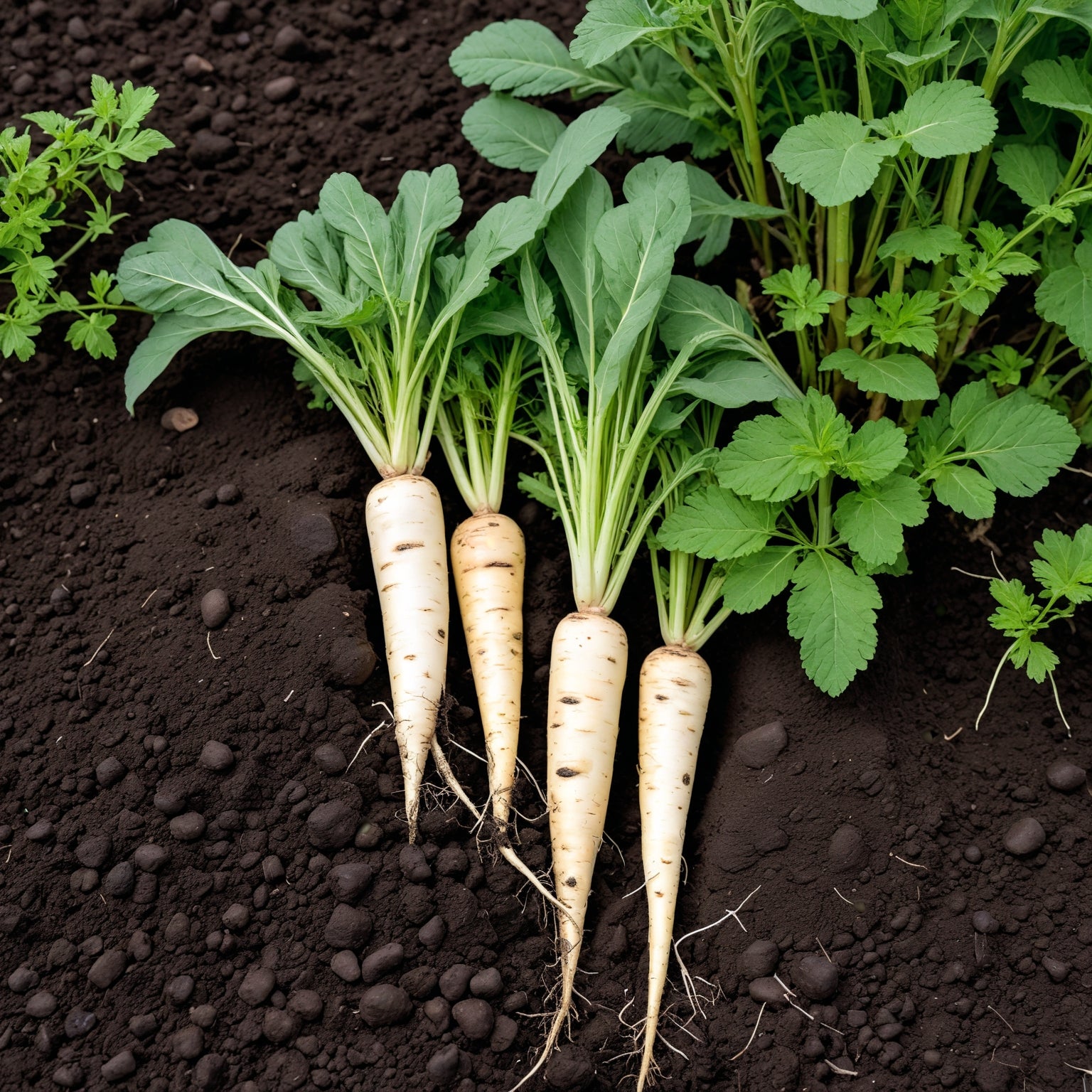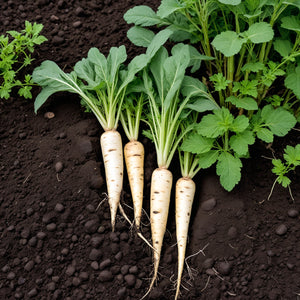- Hardiness Zone: 2-10 Biennial Typically Grown As Annual
Why You’ll Love It
All American Parsnip is a time-tested heirloom known for its dependable growth and exceptional flavor. The tapered roots grow deep and long in loose soil, developing their signature sweetness after a touch of frost. Great for fall and winter harvests, this variety offers high yields and stores well in cool conditions. Its creamy texture and nutty, sweet flavor make it a favorite for roasting, soups, and hearty cold-weather dishes.
Plant Characteristics
Height: 12–18 inches
Growth Habit: Upright leafy tops with deep root development
Root Type: Long, white, tapered roots with smooth skin
Days to Maturity: 95–120 days
Hardiness: Cool-season biennial grown as an annual
Flavor and Culinary Uses
Flavor: Sweet, earthy, and nutty with a smooth texture
Culinary Uses: Excellent roasted, mashed, in soups, stews, or blended into purees. Adds depth to broths and root vegetable mixes.
Companion Planting Tips
Good Companions: Onions, leeks, radishes, and bush beans
Avoid Planting Near: Carrots (to reduce competition and pest overlap)
Bonus Benefit: Flavor improves dramatically after a frost — perfect for late fall and winter meals
Common Issues and Solutions
Poor Germination: Parsnips germinate slowly — use fresh seed each year and keep soil consistently moist
Forked or Misshapen Roots: Grow in deep, loose soil free of stones and compacted layers
Pest Pressure (Carrot Rust Fly): Rotate crops and consider using floating row covers for protection
Seeds Per Packet
| 1g | Approximately 176 |
| 3g | Approximately 528 |
| 5g | Approximately 880 |
| 7g | Approximately 1,232 |
Why You’ll Love It
All American Parsnip is a time-tested heirloom known for its dependable growth and exceptional flavor. The tapered roots grow deep and long in loose soil, developing their signature sweetness after a touch of frost. Great for fall and winter harvests, this variety offers high yields and stores well in cool conditions. Its creamy texture and nutty, sweet flavor make it a favorite for roasting, soups, and hearty cold-weather dishes.
Plant Characteristics
Height: 12–18 inches
Growth Habit: Upright leafy tops with deep root development
Root Type: Long, white, tapered roots with smooth skin
Days to Maturity: 95–120 days
Hardiness: Cool-season biennial grown as an annual
Flavor and Culinary Uses
Flavor: Sweet, earthy, and nutty with a smooth texture
Culinary Uses: Excellent roasted, mashed, in soups, stews, or blended into purees. Adds depth to broths and root vegetable mixes.
Companion Planting Tips
Good Companions: Onions, leeks, radishes, and bush beans
Avoid Planting Near: Carrots (to reduce competition and pest overlap)
Bonus Benefit: Flavor improves dramatically after a frost — perfect for late fall and winter meals
Common Issues and Solutions
Poor Germination: Parsnips germinate slowly — use fresh seed each year and keep soil consistently moist
Forked or Misshapen Roots: Grow in deep, loose soil free of stones and compacted layers
Pest Pressure (Carrot Rust Fly): Rotate crops and consider using floating row covers for protection
Seeds Per Packet
| 1g | Approximately 176 |
| 3g | Approximately 528 |
| 5g | Approximately 880 |
| 7g | Approximately 1,232 |
Seed Depth: 1/2 inch
Seed Spacing: 3–6 inches
Row Spacing: 18–24 inches
Sunlight: Full sun to partial shade
Days to Sprout: 14–21 days
Days to Maturity: 100–130 days
Growth Habit: Upright, root crop
Sunlight: Prefers full sun but tolerates partial shade, especially in warmer climates.
Soil Type: Prefers deep, loose, well-drained soil with a pH of 6.0–7.0. Remove rocks and debris to prevent misshapen roots.
When to Plant: Sow seeds directly outdoors in early spring as soon as the soil is workable, or in late summer for a fall harvest. Parsnips require a long growing season and benefit from cooler temperatures.
Direct Sowing: Plant seeds 1/2 inch deep and 3–6 inches apart in rows 18–24 inches apart. Thin seedlings as needed.
Indoor Sowing: Not recommended; parsnips grow best when directly sown outdoors.
Succession Planting: Not typically needed; a single planting yields a long harvest window.
Watering: Water deeply and consistently to keep soil evenly moist but not waterlogged. Inconsistent watering can lead to tough roots.
Fertilizing: Apply a balanced fertilizer or compost at planting and mid-season to encourage healthy root development. Avoid over-fertilizing with nitrogen, which promotes foliage over roots.
Pruning: No pruning is required, but regular weeding helps prevent competition.
Pest and Disease Control: Monitor for carrot flies and leaf spot. Use row covers and crop rotation to minimize pest and disease risks.
When to Harvest: Harvest roots when they are 10–12 inches long and firm, typically 100–130 days after planting. For the sweetest flavor, wait until after the first frost.
How to Harvest: Use a garden fork to gently loosen the soil around the roots and pull them out carefully to avoid damage.
Seed Collection: Allow some plants to bolt in their second year to produce seeds. Collect seeds once they are fully dry.
Storing Seeds: Store seeds in an airtight container in a cool, dry place.






Share and get 15% off!
Simply share this product on one of the following social networks and you will unlock 15% off!